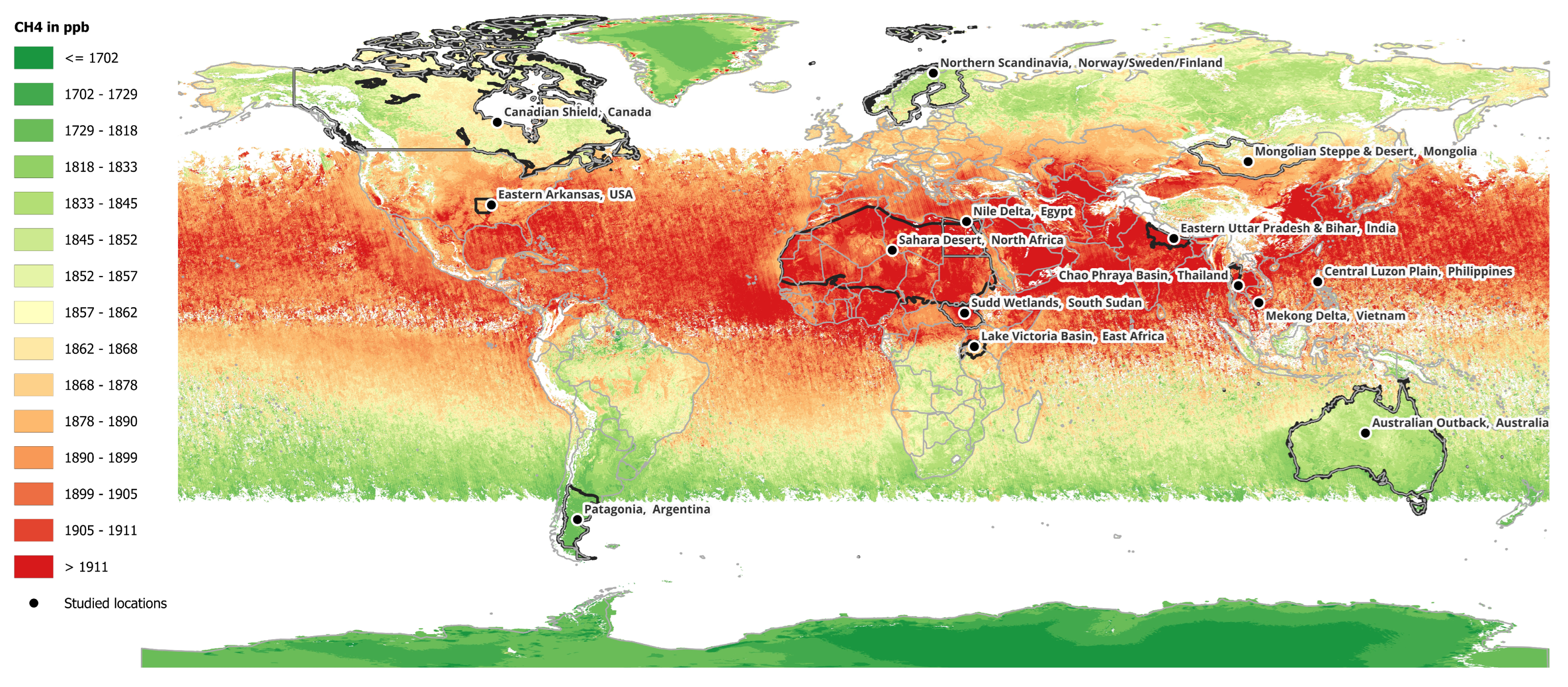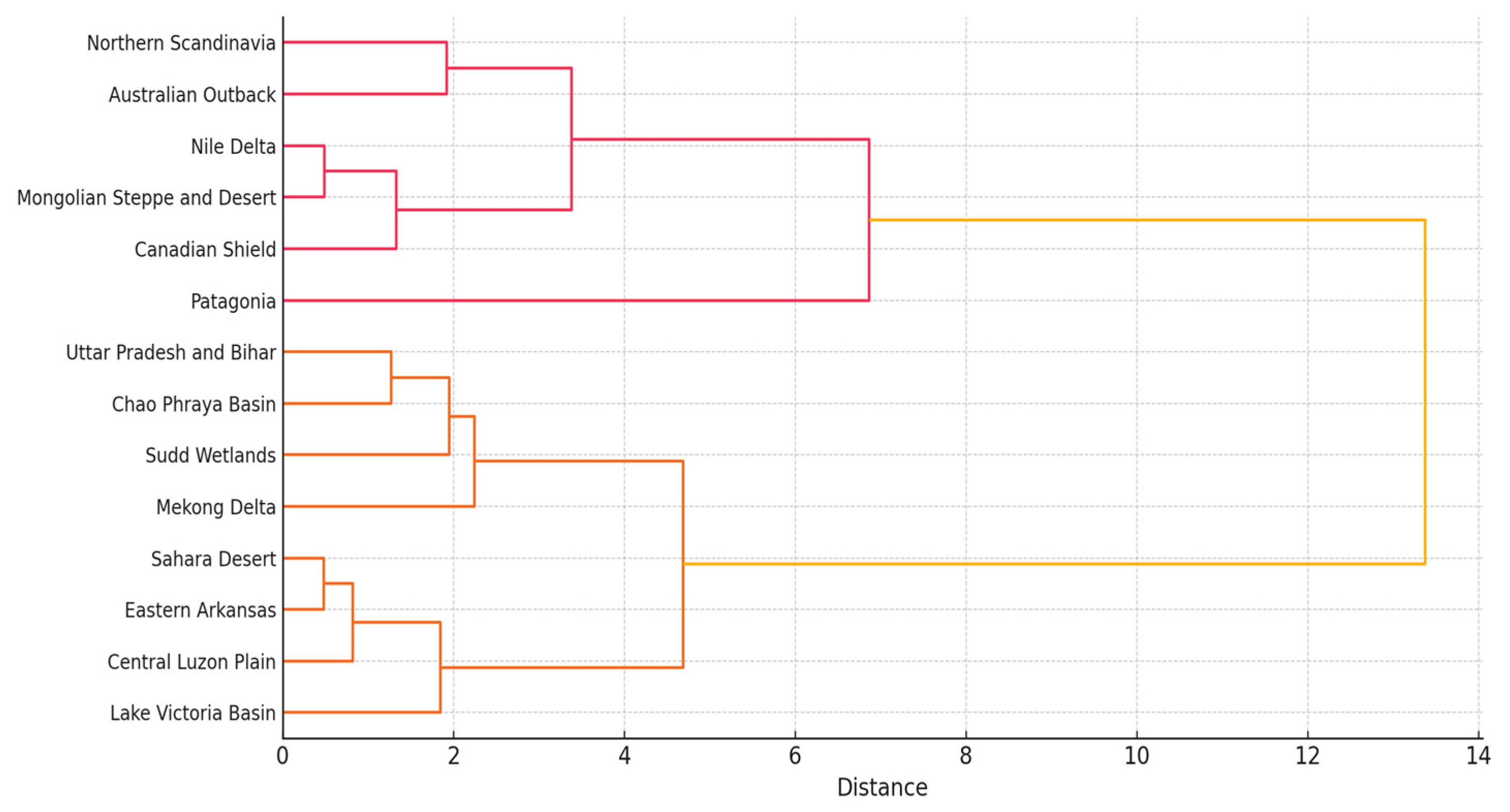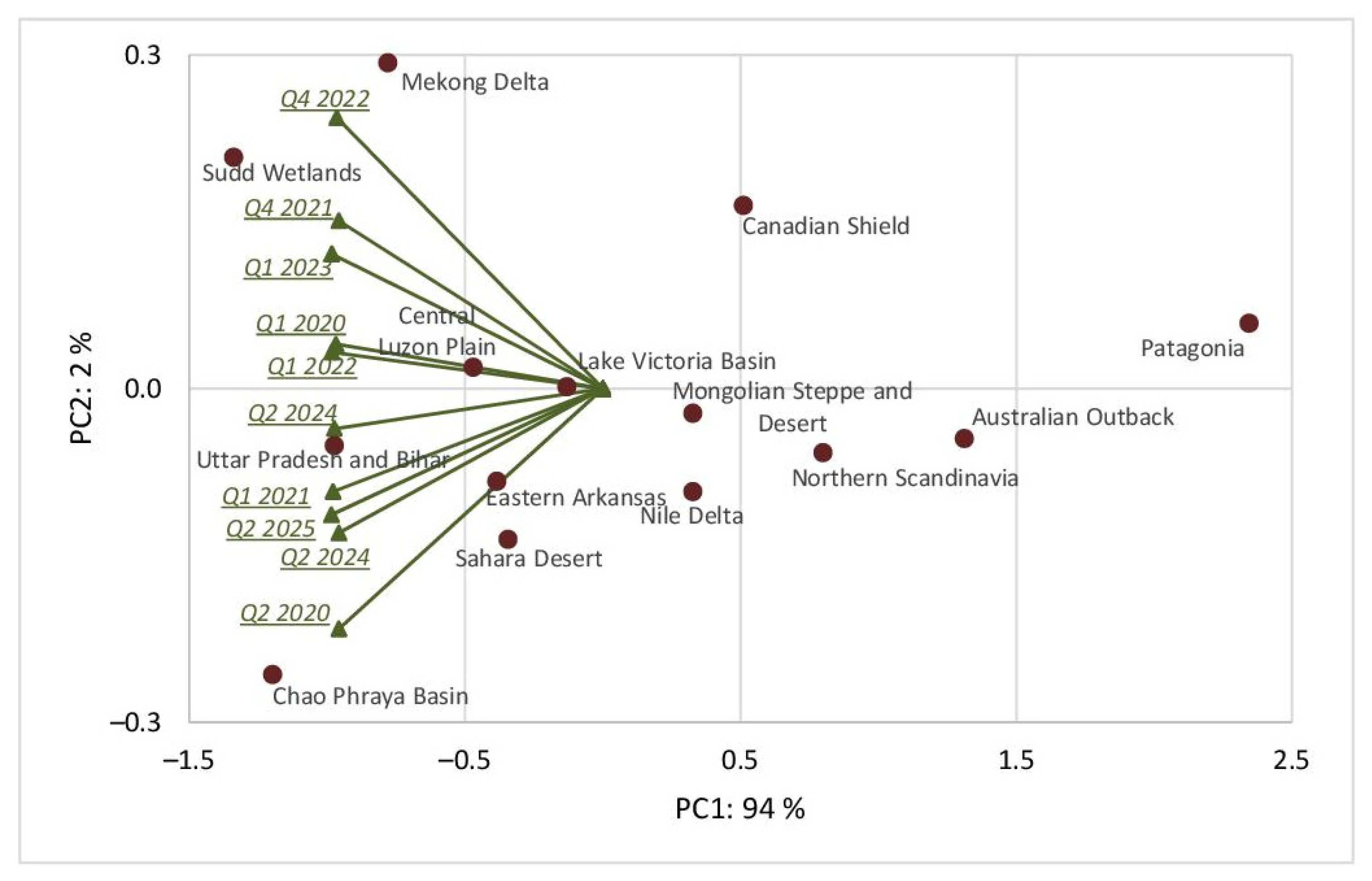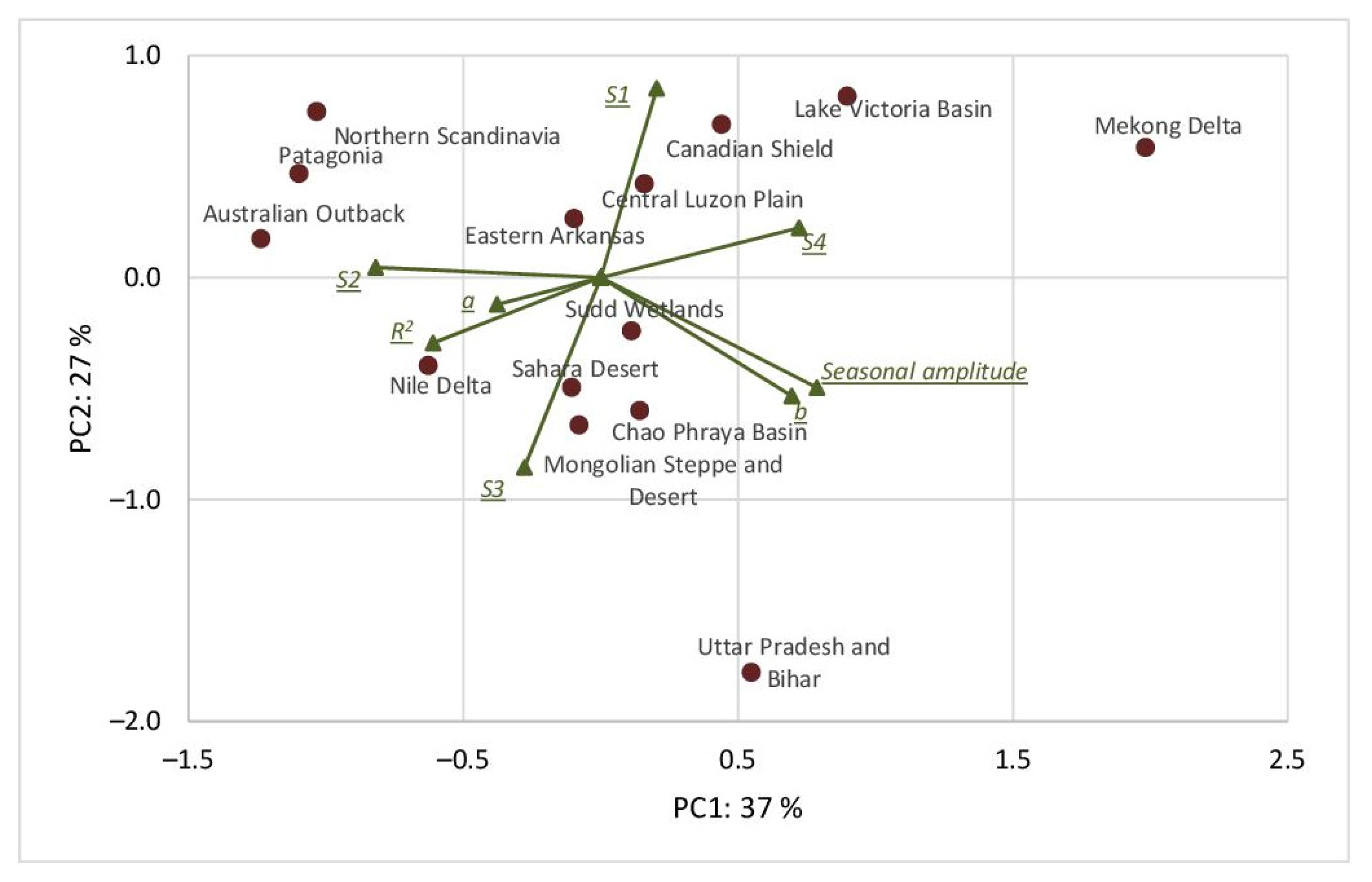Spatio-Temporal Patterns of Methane Emissions from 2019 Onwards: A Satellite-Based Comparison of High- and Low-Emission Regions
Abstract
1. Introduction
2. Materials and Methods
2.1. Study Area Selection
2.2. Satellite Data and Preprocessing
2.3. Trend and Seasonal Analysis
3. Results
3.1. Overall Trends in Methane Concentration
3.2. Trends and Seasonal Variations
3.3. Multivariate Analysis of Regional Time Series
3.4. Exploring Drivers of Methane Variability
4. Discussion
5. Conclusions
Author Contributions
Funding
Institutional Review Board Statement
Informed Consent Statement
Data Availability Statement
Acknowledgments
Conflicts of Interest
References
- Intergovernmental Panel on Climate, C. Climate Change 2021—The Physical Science Basis: Working Group I Contribution to the Sixth Assessment Report of the Intergovernmental Panel on Climate Change; Cambridge University Press: Cambridge, UK, 2023. [Google Scholar]
- Myhre, G.; Shindell, D.; Bréon, F.-M.; Collins, W.; Fuglestvedt, J.; Huang, J.; Koch, D.; Lamarque, J.-F.; Lee, D.; Mendoza, B.; et al. Anthropogenic and Natural Radiative Forcing. In Climate Change 2013—The Physical Science Basis; Cambridge University Press: Cambridge, UK, 2014; pp. 659–740. [Google Scholar]
- Sonnemann, G.R.; Grygalashvyly, M. Global annual methane emission rate derived from its current atmospheric mixing ratio and estimated lifetime. Ann. Geophys. 2014, 32, 277–283. [Google Scholar] [CrossRef]
- Etminan, M.; Myhre, G.; Highwood, E.J.; Shine, K.P. Radiative forcing of carbon dioxide, methane, and nitrous oxide: A significant revision of the methane radiative forcing. Geophys. Res. Lett. 2016, 43, 12614–12623. [Google Scholar] [CrossRef]
- Forster, P.; Ramaswamy, V.; Artaxo, P.; Berntsen, T.; Betts, R.; Fahey, D.W.; Haywood, J.; Lean, J.; Lowe, D.C.; Myhre, G.; et al. Changes in Atmospheric Constituents and in Radiative Forcing. In Climate Change 2007: The Physical Science Basis. Contribution of Working Group I to the Fourth Assessment Report of the Intergovernmental Panel on Climate Change; Solomon, S., Qin, D., Manning, M., Chen, Z., Marquis, M., Averyt, K.B., Tignor, M., Miller, H.L., Eds.; Cambridge University Press: Cambridge, UK; New York, NY, USA, 2007. [Google Scholar]
- Saunois, M.; Stavert, A.R.; Poulter, B.; Bousquet, P.; Canadell, J.G.; Jackson, R.B.; Raymond, P.A.; Dlugokencky, E.J.; Houweling, S.; Patra, P.K.; et al. The Global Methane Budget 2000–2017. Earth Syst. Sci. Data 2020, 12, 1561–1623. [Google Scholar] [CrossRef]
- Nisbet, E.G.; Manning, M.; Dlugokencky, E.; Fisher, R.; Lowry, D.; Michel, S.; Myhre, C.L.; Platt, S.M.; Allen, G.; Bousquet, P. Very strong atmospheric methane growth in the 4 years 2014–2017: Implications for the Paris Agreement. Glob. Biogeochem. Cycles 2019, 33, 318–342. [Google Scholar] [CrossRef]
- Schwietzke, S.; Sherwood, O.A.; Bruhwiler, L.M.P.; Miller, J.B.; Etiope, G.; Dlugokencky, E.J.; Michel, S.E.; Arling, V.A.; Vaughn, B.H.; White, J.W.C.; et al. Upward revision of global fossil fuel methane emissions based on isotope database. Nature 2016, 538, 88–91. [Google Scholar] [CrossRef] [PubMed]
- Patra, P.K.; Saeki, T.; Dlugokencky, E.J.; Ishijima, K.; Umezawa, T.; Ito, A.; Aoki, S.; Morimoto, S.; Kort, E.A.; Crotwell, A.; et al. Regional Methane Emission Estimation Based on Observed Atmospheric Concentrations (2002–2012). J. Meteorol. Soc. Japan. Ser. II 2016, 94, 91–113. [Google Scholar] [CrossRef]
- Rößger, N.; Sachs, T.; Wille, C.; Boike, J.; Kutzbach, L. Seasonal increase of methane emissions linked to warming in Siberian tundra. Nat. Clim. Change 2022, 12, 1031–1036. [Google Scholar] [CrossRef]
- Hu, H.; Landgraf, J.; Detmers, R.; Borsdorff, T.; Aan De Brugh, J.; Aben, I.; Butz, A.; Hasekamp, O. Toward Global Mapping of Methane With TROPOMI: First Results and Intersatellite Comparison to GOSAT. Geophys. Res. Lett. 2018, 45, 3682–3689. [Google Scholar] [CrossRef]
- Lorente, A.; Borsdorff, T.; Butz, A.; Hasekamp, O.; aan de Brugh, J.; Schneider, A.; Wu, L.; Hase, F.; Kivi, R.; Wunch, D.; et al. Methane retrieved from TROPOMI: Improvement of the data product and validation of the first 2 years of measurements. Atmos. Meas. Tech. 2021, 14, 665–684. [Google Scholar] [CrossRef]
- Saad, K.M.; Wunch, D.; Toon, G.C.; Bernath, P.; Boone, C.; Connor, B.; Deutscher, N.M.; Griffith, D.W.T.; Kivi, R.; Notholt, J.; et al. Derivation of tropospheric methane from TCCON CH4 and HF total column observations. Atmos. Meas. Tech. 2014, 7, 2907–2918. [Google Scholar] [CrossRef]
- De Mazière, M.; Thompson, A.M.; Kurylo, M.J.; Wild, J.D.; Bernhard, G.; Blumenstock, T.; Braathen, G.O.; Hannigan, J.W.; Lambert, J.C.; Leblanc, T.; et al. The Network for the Detection of Atmospheric Composition Change (NDACC): History, status and perspectives. Atmos. Chem. Phys. 2018, 18, 4935–4964. [Google Scholar] [CrossRef]
- Alberti, C.; Hase, F.; Frey, M.; Dubravica, D.; Blumenstock, T.; Dehn, A.; Castracane, P.; Surawicz, G.; Harig, R.; Baier, B.C.; et al. Improved calibration procedures for the EM27/SUN spectrometers of the COllaborative Carbon Column Observing Network (COCCON). Atmos. Meas. Tech. 2022, 15, 2433–2463. [Google Scholar] [CrossRef]
- Karion, A.; Sweeney, C.; Tans, P.; Newberger, T. AirCore: An Innovative Atmospheric Sampling System. J. Atmos. Ocean. Technol. 2010, 27, 1839–1853. [Google Scholar] [CrossRef]
- Sha, M.K.; Langerock, B.; Blavier, J.F.L.; Blumenstock, T.; Borsdorff, T.; Buschmann, M.; Dehn, A.; De Mazière, M.; Deutscher, N.M.; Feist, D.G.; et al. Validation of methane and carbon monoxide from Sentinel-5 Precursor using TCCON and NDACC-IRWG stations. Atmos. Meas. Tech. 2021, 14, 6249–6304. [Google Scholar] [CrossRef]
- Lindqvist, H.; Kivimäki, E.; Häkkilä, T.; Tsuruta, A.; Schneising, O.; Buchwitz, M.; Lorente, A.; Martinez Velarte, M.; Borsdorff, T.; Alberti, C.; et al. Evaluation of Sentinel-5P TROPOMI Methane Observations at Northern High Latitudes. Remote Sens. 2024, 16, 2979. [Google Scholar] [CrossRef]
- Kirschke, S.; Bousquet, P.; Ciais, P.; Saunois, M.; Canadell, J.G.; Dlugokencky, E.J.; Bergamaschi, P.; Bergmann, D.; Blake, D.R.; Bruhwiler, L.; et al. Three decades of global methane sources and sinks. Nat. Geosci. 2013, 6, 813–823. [Google Scholar] [CrossRef]
- Bloom, A.A.; Bowman, K.W.; Lee, M.; Turner, A.J.; Schroeder, R.; Worden, J.R.; Weidner, R.; McDonald, K.C.; Jacob, D.J. A global wetland methane emissions and uncertainty dataset for atmospheric chemical transport models (WetCHARTs version 1.0). Geosci. Model Dev. 2017, 10, 2141–2156. [Google Scholar] [CrossRef]
- Bousquet, P.; Ciais, P.; Miller, J.B.; Dlugokencky, E.J.; Hauglustaine, D.A.; Prigent, C.; Van der Werf, G.R.; Peylin, P.; Brunke, E.G.; Carouge, C.; et al. Contribution of anthropogenic and natural sources to atmospheric methane variability. Nature 2006, 443, 439–443. [Google Scholar] [CrossRef]
- Tong, Y.D. Rice intensive cropping and balanced cropping in the Mekong Delta, Vietnam—Economic and ecological considerations. Ecol. Econ. 2017, 132, 205–212. [Google Scholar] [CrossRef]
- Radwan, T.M.; Blackburn, G.A.; Whyatt, J.D.; Atkinson, P.M. Dramatic loss of agricultural land due to urban expansion threatens food security in the Nile Delta, Egypt. Remote Sens. 2019, 11, 332. [Google Scholar] [CrossRef]
- Kumar, N.; Chhokar, R.; Meena, R.; Kharub, A.; Gill, S.; Tripathi, S.; Gupta, O.; Mangrauthia, S.; Sundaram, R.; Sawant, C. Challenges and opportunities in productivity and sustainability of rice cultivation system: A critical review in Indian perspective. Cereal Res. Commun. 2021, 50, 573–601. [Google Scholar] [CrossRef]
- Molle, F. Scales and power in river basin management: The Chao Phraya River in Thailand 1. Geogr. J. 2007, 173, 358–373. [Google Scholar] [CrossRef]
- Were, D.; Kansiime, F.; Fetahi, T.; Hein, T. Carbon dioxide and methane fluxes from a tropical freshwater wetland under natural and rice paddy conditions: Implications for climate change mitigation. Wetlands 2021, 41, 52. [Google Scholar] [CrossRef]
- Humphreys, J.; Brye, K.R.; Rector, C.; Gbur, E.E. Methane emissions from rice across a soil organic matter gradient in Alfisols of Arkansas, USA. Geoderma Reg. 2019, 16, e00200. [Google Scholar] [CrossRef]
- Silva, J.V.; Reidsma, P.; Velasco, M.L.; Laborte, A.G.; van Ittersum, M.K. Intensification of rice-based farming systems in Central Luzon, Philippines: Constraints at field, farm and regional levels. Agric. Syst. 2018, 165, 55–70. [Google Scholar] [CrossRef]
- Busso, C.A.; Fernández, O.A. Arid and semiarid rangelands of Argentina. In Climate Variability Impacts on Land Use and Livelihoods in Drylands; Springer: Berlin/Heidelberg, Germany, 2018; pp. 261–291. [Google Scholar]
- Pfeiffer, M.; Dulamsuren, C.; Jäschke, Y.; Wesche, K. Grasslands of China and Mongolia: Spatial extent, land use and conservation. In Grasslands of the World: Diversity, Management and Conservation; Routledge: London, UK, 2018; pp. 168–196. [Google Scholar]
- Virtanen, R.; Oksanen, L.; Oksanen, T.; Cohen, J.; Forbes, B.C.; Johansen, B.; Käyhkö, J.; Olofsson, J.; Pulliainen, J.; Tømmervik, H. Where do the treeless tundra areas of northern highlands fit in the global biome system: Toward an ecologically natural subdivision of the tundra biome. Ecol. Evol. 2016, 6, 143–158. [Google Scholar] [CrossRef]
- Finn, D.; Dalal, R.; Klieve, A. Methane in Australian agriculture: Current emissions, sources and sinks, and potential mitigation strategies. Crop Pasture Sci. 2014, 66, 1–22. [Google Scholar] [CrossRef]
- Prăvălie, R. Drylands extent and environmental issues. A global approach. Earth-Sci. Rev. 2016, 161, 259–278. [Google Scholar] [CrossRef]
- Price, D.T.; Alfaro, R.I.; Brown, K.; Flannigan, M.D.; Fleming, R.A.; Hogg, E.H.; Girardin, M.P.; Lakusta, T.; Johnston, M.; McKenney, D.W. Anticipating the consequences of climate change for Canada’s boreal forest ecosystems. Environ. Rev. 2013, 21, 322–365. [Google Scholar] [CrossRef]
- Rebelo, L.-M.; Senay, G.B.; McCartney, M.P. Flood pulsing in the Sudd wetland: Analysis of seasonal variations in inundation and evaporation in South Sudan. Earth Interact. 2012, 16, 1–19. [Google Scholar] [CrossRef]
- Gorelick, N.; Hancher, M.; Dixon, M.; Ilyushchenko, S.; Thau, D.; Moore, R. Google Earth Engine: Planetary-scale geospatial analysis for everyone. Remote Sens. Environ. 2017, 202, 18–27. [Google Scholar] [CrossRef]
- Drinkwater, A.; Palmer, P.I.; Feng, L.; Arnold, T.; Lan, X.; Michel, S.E.; Parker, R.; Boesch, H. Atmospheric data support a multi-decadal shift in the global methane budget towards natural tropical emissions. Atmos. Chem. Phys. 2023, 23, 8429–8452. [Google Scholar] [CrossRef]
- Yu, X.; Millet, D.B.; Henze, D.K.; Turner, A.J.; Delgado, A.L.; Bloom, A.A.; Sheng, J. A high-resolution satellite-based map of global methane emissions reveals missing wetland, fossil fuel, and monsoon sources. Atmos. Chem. Phys. 2023, 23, 3325–3346. [Google Scholar] [CrossRef]
- Kozicka, K.; Gozdowski, D.; Wójcik-Gront, E. Spatial-Temporal Changes of Methane Content in the Atmosphere for Selected Countries and Regions with High Methane Emission from Rice Cultivation. Atmosphere 2021, 12, 1382. [Google Scholar] [CrossRef]
- Kumaraswamy, S.; Kumar Rath, A.; Ramakrishnan, B.; Sethunathan, N. Wetland rice soils as sources and sinks of methane: A review and prospects for research. Biol. Fertil. Soils 2000, 31, 449–461. [Google Scholar] [CrossRef]
- Conrad, R. Methane production in soil environments—Anaerobic biogeochemistry and microbial life between flooding and desiccation. Microorganisms 2020, 8, 881. [Google Scholar] [CrossRef]
- Sabrekov, A.F.; Runkle, B.R.; Glagolev, M.V.; Terentieva, I.E.; Stepanenko, V.M.; Kotsyurbenko, O.R.; Maksyutov, S.S.; Pokrovsky, O.S. Variability in methane emissions from West Siberia’s shallow boreal lakes on a regional scale and its environmental controls. Biogeosciences 2017, 14, 3715–3742. [Google Scholar] [CrossRef]
- Laanbroek, H.J. Methane emission from natural wetlands: Interplay between emergent macrophytes and soil microbial processes. A mini-review. Ann. Bot. 2010, 105, 141–153. [Google Scholar] [CrossRef]
- Kotsyurbenko, O.; Glagolev, M.; Merkel, A.; Sabrekov, A.; Terentieva, I. Methanogenesis in soils, wetlands, and peat. In Biogenesis of Hydrocarbons; Springer: Berlin/Heidelberg, Germany, 2019; pp. 211–228. [Google Scholar]
- Miesner, F.; Overduin, P.P.; Grosse, G.; Strauss, J.; Langer, M.; Westermann, S.; Schneider von Deimling, T.; Brovkin, V.; Arndt, S. Subsea permafrost organic carbon stocks are large and of dominantly low reactivity. Sci. Rep. 2023, 13, 9425. [Google Scholar] [CrossRef]
- Bao, T.; Xu, X.; Jia, G.; Billesbach, D.P.; Sullivan, R.C. Much stronger tundra methane emissions during autumn freeze than spring thaw. Glob. Change Biol. 2021, 27, 376–387. [Google Scholar] [CrossRef]
- Zhang, Y.; Fang, S.; Chen, J.; Lin, Y.; Chen, Y.; Liang, R.; Jiang, K.; Parker, R.J.; Boesch, H.; Steinbacher, M. Observed changes in China’s methane emissions linked to policy drivers. Proc. Natl. Acad. Sci. USA 2022, 119, e2202742119. [Google Scholar] [CrossRef] [PubMed]
- Kozicka, K.; Orazalina, Z.; Gozdowski, D.; Wójcik-Gront, E. Evaluation of temporal changes in methane content in the atmosphere for areas with a very high rice concentration based on Sentinel-5P data. Remote Sens. Appl. Soc. Environ. 2023, 30, 100972. [Google Scholar] [CrossRef]
- Lunt, M.F.; Palmer, P.I.; Feng, L.; Taylor, C.M.; Boesch, H.; Parker, R.J. An increase in methane emissions from tropical Africa between 2010 and 2016 inferred from satellite data. Atmos. Chem. Phys. 2019, 19, 14721–14740. [Google Scholar] [CrossRef]







| Region Name | Dominant Land Use | Climate Zone | % Rice Cultivation Area | Population Density (Persons/km2) | References |
|---|---|---|---|---|---|
| Mekong Delta, Vietnam | Intensive rice agriculture | Humid tropical | 65% | 500+ | [22] |
| Nile Delta, Egypt | Rice agriculture, urbanization | Mediterranean/subtropical | 30% | 1000+ | [23] |
| Eastern Uttar Pradesh and Bihar, India | Rice agriculture | Humid subtropical | 50% | 900+ | [24] |
| Chao Phraya Basin, Thailand | Rice agriculture, canal networks | Tropical monsoon | 45% | 800+ | [25] |
| Lake Victoria Basin, East Africa | Natural wetlands, rice agriculture | Tropical savanna | 10% | 300+ | [26] |
| Eastern Arkansas, USA | Mechanized rice agriculture | Humid subtropical | 35% | 50–100 | [27] |
| Central Luzon Plain, Philippines | Irrigated rice agriculture | Tropical monsoon | 55–60% | 300–500 | [28] |
| Patagonia, Argentina | Extensive grazing, natural grassland | Cold semi-arid | 1% | <5 | [29] |
| Mongolian Steppe and Desert, Mongolia | Sparse grassland, desert | Cold desert | 0% | <2 | [30] |
| Northern Scandinavia, Norway/Sweden/Finland | Boreal forest, tundra | Subarctic | 0% | <5 | [31] |
| Australian Outback, Australia | Arid shrubland, desert | Arid desert | 0% | <1 | [32] |
| Sahara Desert, North Africa | Desert, minimal vegetation | Hyper-arid desert | 0% | <1 | [33] |
| Canadian Shield, Canada | Boreal forest, lakes | Subarctic/boreal | 0% | <2 | [34] |
| Sudd Wetlands, South Sudan | Tropical wetlands, floodplains | Tropical savanna | <1% | 10–30 | [35] |
| Region | S1 1 January–31 March | S2 1 April–30 June | S3 1 July–30 September | S4 1 October–31 December | a | b | R2 | Seasonal Amplitude |
|---|---|---|---|---|---|---|---|---|
| Mekong Delta, Vietnam | 2.85 | −24.24 | −27.49 | 13.86 | 1.56 | 1883.96 | 0.66 | 41.35 |
| Nile Delta, Egypt | −11.27 | −1.91 | 6.78 | 6.39 | 2.45 | 1847.29 | 0.92 | 18.05 |
| Eastern Uttar Pradesh and Bihar, India | −16.31 | −9.81 | 35.61 | 8.04 | 2.44 | 1892.51 | 0.85 | 51.92 |
| Chao Phraya Basin, Thailand | −0.74 | −6.9 | 22.95 | −0.02 | 2.43 | 1888.58 | 0.69 | 29.85 |
| Lake Victoria Basin, East Africa | 8.26 | −8.09 | −8.77 | 17.21 | 1.95 | 1858.36 | 0.69 | 25.98 |
| Eastern Arkansas, USA | −3.85 | −2.87 | −3.54 | 10.27 | 2.83 | 1859.11 | 0.69 | 14.12 |
| Central Luzon Plain, Philippines | 1.77 | −0.31 | −16.48 | 12.27 | 2.37 | 1862.93 | 0.86 | 28.75 |
| Patagonia, Argentina | −2.88 | −3.31 | 3.22 | 2.23 | 1.84 | 1788.48 | 0.93 | 6.53 |
| Mongolian Steppe and Desert, Mongolia | −13.61 | −8.56 | 11.85 | 10.33 | 2.15 | 1852.93 | 0.94 | 25.46 |
| Northern Scandinavia, Norway/Sweden/Finland | 6.08 | 0.86 | −7.32 | 1.50 | 3.11 | 1810.8 | 0.82 | 13.40 |
| Australian Outback, Australia | −5.53 | 3.29 | 2.03 | 0.20 | 2.14 | 1816.93 | 0.91 | 8.82 |
| Sahara Desert, North Africa | −10.25 | −5.02 | 8.48 | 10.31 | 2.11 | 1871.88 | 0.93 | 20.56 |
| Canadian Shield, Canada | 3.14 | −6.99 | −4.57 | 16.84 | 2.37 | 1829.53 | 0.70 | 23.83 |
| Sudd Wetlands, South Sudan | −11.64 | 2.77 | −3.90 | 11.47 | 3.00 | 1888.61 | 0.62 | 23.11 |
Disclaimer/Publisher’s Note: The statements, opinions and data contained in all publications are solely those of the individual author(s) and contributor(s) and not of MDPI and/or the editor(s). MDPI and/or the editor(s) disclaim responsibility for any injury to people or property resulting from any ideas, methods, instructions or products referred to in the content. |
© 2025 by the authors. Licensee MDPI, Basel, Switzerland. This article is an open access article distributed under the terms and conditions of the Creative Commons Attribution (CC BY) license (https://creativecommons.org/licenses/by/4.0/).
Share and Cite
Wójcik-Gront, E.; Wnuk, A.; Gozdowski, D. Spatio-Temporal Patterns of Methane Emissions from 2019 Onwards: A Satellite-Based Comparison of High- and Low-Emission Regions. Atmosphere 2025, 16, 670. https://doi.org/10.3390/atmos16060670
Wójcik-Gront E, Wnuk A, Gozdowski D. Spatio-Temporal Patterns of Methane Emissions from 2019 Onwards: A Satellite-Based Comparison of High- and Low-Emission Regions. Atmosphere. 2025; 16(6):670. https://doi.org/10.3390/atmos16060670
Chicago/Turabian StyleWójcik-Gront, Elżbieta, Agnieszka Wnuk, and Dariusz Gozdowski. 2025. "Spatio-Temporal Patterns of Methane Emissions from 2019 Onwards: A Satellite-Based Comparison of High- and Low-Emission Regions" Atmosphere 16, no. 6: 670. https://doi.org/10.3390/atmos16060670
APA StyleWójcik-Gront, E., Wnuk, A., & Gozdowski, D. (2025). Spatio-Temporal Patterns of Methane Emissions from 2019 Onwards: A Satellite-Based Comparison of High- and Low-Emission Regions. Atmosphere, 16(6), 670. https://doi.org/10.3390/atmos16060670






